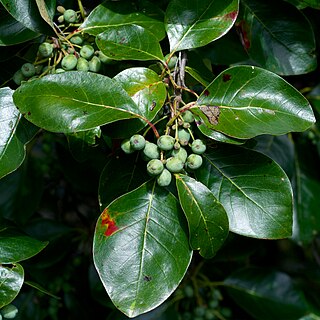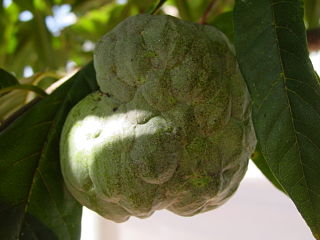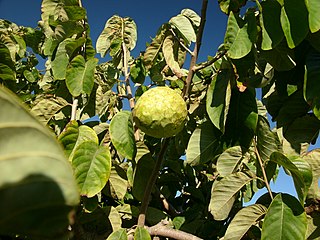
Nyssa sylvatica, commonly known as tupelo, black tupelo, black gum or sour gum, is a medium-sized deciduous tree native to eastern North America from the coastal Northeastern United States and southern Ontario south to central Florida and eastern Texas, as well as Mexico.

Soursop is the fruit of Annona muricata, a broadleaf, flowering, evergreen tree. It is native to the tropical regions of the Americas and the Caribbean and is widely propagated. It is in the same genus, Annona, as cherimoya and is in the Annonaceae family.

The Annonaceae are a family of flowering plants consisting of trees, shrubs, or rarely lianas commonly known as the custard apple family or soursop family. With 108 accepted genera and about 2400 known species, it is the largest family in the Magnoliales. Several genera produce edible fruit, most notably Annona, Anonidium, Asimina, Rollinia, and Uvaria. Its type genus is Annona. The family is concentrated in the tropics, with few species found in temperate regions. About 900 species are Neotropical, 450 are Afrotropical, and the remaining are Indomalayan.

Fagus sylvatica, the European beech or common beech, is a large, graceful deciduous tree in the beech family with smooth silvery-gray bark, large leaf area, and a short trunk with low branches.

The cherimoya, also spelled chirimoya and called chirimuya by the Inca people, is a species of edible fruit-bearing plant in the genus Annona, from the family Annonaceae, which includes the closely related sweetsop and soursop. The plant has long been believed to be native to Ecuador and Peru, with cultivation practised in the Andes and Central America, although a recent hypothesis postulates Central America as the origin instead, because many of the plant's wild relatives occur in this area.

Annona or Anona is a genus of flowering plants in the pawpaw/sugar apple family, Annonaceae. It is the second largest genus in the family after Guatteria, containing approximately 166 species of mostly Neotropical and Afrotropical trees and shrubs.

Annona reticulata is a small deciduous or semi-evergreen tree in the plant family Annonaceae. It is best known for its fruit, called custard apple, a common name shared with fruits of several other species in the same genus: A. cherimola and A. squamosa. Other English common names include ox heart and bullock's heart. The fruit is sweet and useful in preparation of desserts, but is generally less popular for eating than that of A. cherimola.

Annona glabra is a tropical fruit tree in the family Annonaceae, in the same genus as the soursop and cherimoya. Common names include pond apple, alligator apple, swamp apple, corkwood, bobwood, and monkey apple. The tree is native to Florida in the United States, the Caribbean, Central and South America, and West Africa. It is common in the Everglades. The A. glabra tree is considered an invasive species in Sri Lanka and Australia. It grows in swamps, is tolerant of saltwater, and cannot grow in dry soil.

Annona montana, the mountain soursop, is a tree and its edible fruit in the Annonaceae family native to Central America, the Amazon, and islands in the Caribbean. It has fibrous fruits. A. montana may be used as a rootstock for cultivated Annonas.
Annona coriacea is a fruit tree native to Brazil. Its original habitat includes the ecoregions of Cerrado, Caatinga, and Pantanal. There, it is typically found in scrublands and savannahs, though it is sometimes grown in orchards. Its wood is used in constructions and toys. This plant is cited in Flora Brasiliensis by Carl Friedrich Philipp von Martius.

Rollinia is a genus of plants in the family Annonaceae. While it is widely recognised as a distinct genus a monograph published in 2006 advocates its inclusion in Annona, which also contains custard apples and soursops.
Annona conica is a species of plant in the Annonaceae family. It is endemic to Ecuador. Its natural habitats are subtropical or tropical dry forests and subtropical or tropical moist lowland forests. It is threatened by habitat loss. The maximum average height for a domesticated Annona Conica is around 300 cm and in the wild 500 cm.
Annona deceptrix is a species of plant in the Annonaceae family. It is endemic to Ecuador. Its natural habitat is subtropical or tropical moist lowland forests. It is threatened by habitat loss.
Annona ecuadorensis is a species of plant in the Annonaceae family. It is endemic to Ecuador. Its natural habitat is subtropical or tropical moist lowland forests. It is threatened by habitat loss.
Annona hystricoides is a species of plant in the Annonaceae family. It is endemic to Ecuador. Its natural habitat is subtropical or tropical moist lowland forests. It is threatened by habitat loss.
Annona manabiensis is a species of plant in the Annonaceae family. It is endemic to Ecuador. Its natural habitat is subtropical or tropical dry forests. It is threatened by habitat loss.
Annona oligocarpa is a species of plant in the Annonaceae family. It is endemic to Ecuador. Its natural habitats are subtropical or tropical dry forests and subtropical or tropical moist lowland forests. It is threatened by habitat loss.
Rollinia dolichopetala is a species of plant in the Annonaceae family. It is endemic to Ecuador. Its natural habitats are subtropical or tropical moist lowland forests and subtropical or tropical moist montane forests. It is threatened by habitat loss.

Annona mucosa is a species of flowering plant in the custard-apple family, Annonaceae, that is native to tropical South America. It is cultivated for its edible fruits, commonly known as biribá, lemon meringue pie fruit, or wild sugar-apple, throughout the world's tropics and subtropics.

Annona senegalensis, commonly known as African custard-apple, wild custard apple, wild soursop, abo ibobo, sunkungo, and dorgot is a species of flowering plant in the custard apple family, Annonaceae. The specific epithet, senegalensis, translates to mean "of Senegal", the country where the type specimen was collected.














